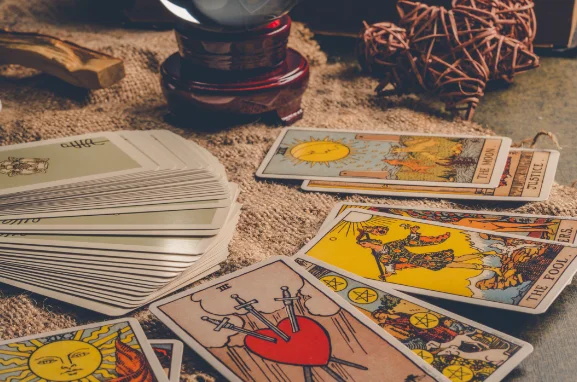Introduction to Tarot and Personal Dynamics
A tarot deck consists of 78 cards, each divided into two main sections: the Major Arcana and the Minor Arcana. The Major Arcana represents significant life themes and personal archetypes, while the Minor Arcana illustrates daily events, interpersonal dynamics, and subtler emotional nuances. When applied thoughtfully, these cards can reveal hidden aspects of our personal and relational lives, providing insights into our behavior, relationships, and future choices. Tarot readings have been utilized for centuries as a powerful tool for gaining insights into our lives. In recent years, tarot has gained popularity for exploring personal dynamics helping people better understand themselves, their relationships, and how they relate to others. This guide delves into how tarot can be used to unlock the secrets of personal dynamics, covering essential tarot cards, specific spreads, practical examples, and interpretations to foster self-awareness and relational understanding
Understanding Tarot Card Sections:
- Major Arcana (22 cards): These cards represent major life lessons and milestones. Examples include The Fool, The Magician, and The World, each embodying significant archetypal energies and lessons.
- Minor Arcana (56 cards): This section is further divided into four suits:
- Cups: Relate to emotions, relationships, and connections.
- Swords: Concern thoughts, conflicts, and decisions.
- Wands: Reflect passion, inspiration, and action.
- Pentacles: Deal with material aspects, finances, and practical matters.
Tarot can serve as a reflective tool for self-discovery, empowering individuals to improve their relationships by understanding their unique patterns and motivations.
Benefits of Tarot for Self and Relationships
Using tarot for self and relational insight has many benefits, especially when the readings focus on specific questions and dynamics. Some of the most notable advantages of tarot for personal growth include:
- Enhanced Self-Awareness: Tarot reveals personal strengths, weaknesses, and unconscious motives, allowing for introspection and better self-awareness. By understanding ourselves more deeply, we can make more informed choices in our relationships.
- Improved Communication Skills: By identifying emotional patterns, tarot helps in understanding how we communicate. This awareness can lead to more effective interactions with others, reducing misunderstandings.
- Conflict Resolution: Tarot can highlight the root causes of misunderstandings or disagreements, making it easier to address issues constructively. This approach fosters healthier relationships by providing clarity on complex emotional situations.
- Understanding Interpersonal Dynamics: Tarot readings provide clues about compatibility, relationship challenges, and potential ways to harmonize personal dynamics. It can reveal how our backgrounds and personalities influence our relationships.
- Guidance for Personal Development: Tarot is a great tool for setting goals and gaining insight into areas of growth. It encourages individuals to take actionable steps toward self-improvement and relationship enhancement.
Key Tarot Cards for Understanding Relationships
Certain tarot cards frequently appear in readings centered on personal dynamics. Below are some key cards, along with their general meanings in the context of relationships and personal insight:
| Tarot Card | Meaning | Interpretation in Relationships |
| The Lovers | Love, harmony, choices. Represents deep connection or decisions related to relationships. | Indicates a meaningful relationship or the need to make a crucial relationship decision. |
| Two of Cups | Emotional bonds, partnership, mutual respect. | Shows balanced partnerships or new emotional connections. |
| The Empress | Nurturing, caring, motherly figure. Reflects creativity and abundance. | Symbolizes a nurturing presence, suggesting the need for support and compassion. |
| The Emperor | Authority, stability, control. Represents a strong, structured influence. | Suggests a desire for control or a stable figure in the relationship. |
| Three of Swords | Heartbreak, sorrow, conflict. | Indicates possible heartbreak or unresolved pain. |
| Ten of Cups | Fulfillment, happiness, family unity. | A positive indicator of a harmonious family life or fulfilling relationships. |
| The Hermit | Solitude, introspection, personal growth. Reflects a period of self-reflection. | Shows the need for space or a time for introspection in relationships. |
| Four of Wands | Celebration, harmony, stability. Symbolizes joy and community. | Represents a stable or celebratory stage in a relationship. |
Practical Examples of Card Interpretations
Example 1: The Lovers and The Two of Cups
If The Lovers card appears alongside the Two of Cups in a reading about a romantic relationship, it suggests a deep emotional connection and significant choices that may need to be made. It indicates that the relationship is based on mutual respect and love, making it essential to discuss future goals and desires.
Example 2: Three of Swords in Conflict Resolution
In a reading focused on conflict resolution, drawing the Three of Swords can highlight unresolved pain or miscommunication. This card suggests that both parties need to acknowledge their feelings and address any heartache before moving forward
Types of Tarot Spreads for Personal Dynamics
To better understand personal dynamics, it’s helpful to use specific tarot spreads that provide structured guidance. Here are a few commonly used spreads for insights into self and relationships:
1. The Self-Reflection Spread
- Purpose: Offers a deep look into one’s inner world and motivations.
- Card Positions:
- Card 1: Current self—represents how you perceive yourself in this moment.
- Card 2: Strengths—highlights your positive traits and abilities.
- Card 3: Weaknesses—reveals areas that may require attention or improvement.
- Card 4: Opportunities for growth—points out areas for potential development.
- Card 5: Advice for moving forward—provides guidance on how to take action.
2. Relationship Dynamics Spread
- Purpose: Helps understand the strengths and challenges within a relationship.
- Card Positions:
- Card 1: You in the relationship—reflects your feelings and contributions.
- Card 2: Partner’s view or role—shows how your partner perceives the dynamic.
- Card 3: Shared emotions—represents the emotional connection between you.
- Card 4: Areas of tension—highlights potential conflicts or misunderstandings.
- Card 5: Guidance or resolution—offers advice for improving the relationship.
3. Conflict Resolution Spread
- Purpose: Addresses specific conflicts, providing insight into resolutions.
- Card Positions:
- Card 1: Your perspective on the conflict—how you view the situation.
- Card 2: Partner’s perspective—how your partner sees the issue.
- Card 3: Core issue—identifies the main problem causing the conflict.
- Card 4: Advice for reconciliation—suggests steps to resolve the conflict.
- Card 5: Likely outcome if advice is followed—indicates possible future results.
Comparative Table of Tarot Spreads for Dynamics
To help decide which spread best suits your needs, here’s a table comparing different tarot spreads used for analyzing personal and relationship dynamics:
| Spread | Purpose | Ideal For | Number of Cards | Time to Complete |
| Self-Reflection | Understand personal motives | Self-awareness, inner work | 5 | 10-15 minutes |
| Relationship Dynamics | Analyze relationship dynamics | Assessing compatibility, strengthening bonds | 5 | 15-20 minutes |
| Conflict Resolution | Resolve conflicts | Conflict mediation and understanding both sides | 5 | 15-20 minutes |
| Personal Growth | Foster personal development | Long-term goals, personal growth | 6 | 20-30 minutes |
| Compatibility Spread | Gauge relationship potential | New relationships, assessing future potential | 4 | 10-15 minutes |
Each of these spreads offers a unique perspective, making them versatile for various situations. By selecting the right spread, you can focus on the specific aspects of personal dynamics you’re interested in exploring.
Steps for an Accurate and Insightful Reading
To ensure the most accurate and insightful tarot reading, follow these steps:
- Create a Calm Environment: Find a quiet space where you can concentrate and reflect without distractions. The environment can significantly influence the reading’s effectiveness.
- Set Your Intention: Clearly define the purpose of your reading. Whether it’s for self-discovery, relationship insights, or conflict resolution, having a focused intention can guide your interpretation.
- Shuffle and Draw Cards: Shuffle the cards while concentrating on your question or intention. Draw the required number of cards based on your chosen spread.
- Examine Each Card: Take your time to reflect on each card’s meaning in the context of your question. Consider both the traditional interpretations and your intuitive feelings about the cards.
- Analyze Relationships Between Cards: Look at how the cards interact with one another. The relationships can reveal deeper insights than analyzing cards in isolation.
- Journal Your Insights: Write down your interpretations and any thoughts that arise during the reading. Journaling can help solidify your insights and track your growth over time.
- Reflect After the Reading: Spend a few moments reflecting on the reading. Consider how the insights might apply to your current life situation and what actionable steps you can take moving forward.
Practical Tips for Accurate Tarot Interpretation
Interpreting tarot cards effectively requires practice and intuition. Here are some practical tips to enhance your interpretation skills:
- Familiarize Yourself with the Deck: Spend time with each card, understanding its symbolism, colors, and imagery. This familiarity will help during readings.
- Trust Your Intuition: While it’s beneficial to refer to guides, allow yourself to interpret cards based on your intuition and feelings as you become more experienced.
- Contextualize Cards: Always consider the question and context when interpreting cards. A card’s meaning can change based on the reading’s focus and surrounding cards.
- Keep Learning: Attend workshops, read books, or join tarot communities. Learning from others and sharing experiences can deepen your understanding and enhance your skills.
- Practice Regularly: Consistent practice is key to becoming proficient in tarot reading. Make it a habit to pull cards daily or weekly, even without specific questions in mind.
Conclusion
Tarot is a versatile and powerful tool for exploring personal dynamics and enhancing self-awareness. By utilizing specific tarot spreads and understanding key cards that represent relationships and personal growth, individuals can unlock insights that lead to deeper understanding and stronger connections with themselves and others.
Through consistent practice and reflection, tarot can aid in personal development, conflict resolution, and creating more fulfilling relationships. Embrace the journey of self-discovery through tarot, and let it illuminate the path to healthier dynamics in your life.
Whether you are a novice or a seasoned tarot reader, remember that each reading is a personal journey. Use this guide as a foundation to deepen your practice and explore the rich tapestry of personal dynamics through tarot.
FAQs
What is tarot and how does it work?
Tarot is a deck of 78 cards used for divination and self-reflection. Each card carries symbolic meanings that can provide insights into personal situations and relationships. During a reading, the cards drawn are interpreted based on their meanings and how they relate to one another, helping to uncover underlying emotions and dynamics.
Can tarot help improve my relationships?
Yes, tarot can be a valuable tool for improving relationships. By providing insights into personal motivations, emotional patterns, and interpersonal dynamics, tarot can help you understand yourself and your partner better, fostering healthier communication and conflict resolution.
What are some key tarot cards related to relationships?
Important tarot cards for relationships include The Lovers (indicating deep connections), Two of Cups (representing partnership and mutual respect), Three of Swords (highlighting heartbreak or conflict), and The Empress (symbolizing nurturing and care). Each card offers unique insights into relationship dynamics.
How can I choose the right tarot spread for my reading?
Choosing the right tarot spread depends on your specific question or intention. For personal insight, the Self-Reflection Spread is useful. For relationship analysis, try the Relationship Dynamics Spread. If you’re seeking to resolve a conflict, the Conflict Resolution Spread may be the best fit.
Do I need to be an expert to read tarot?
No, you don’t need to be an expert to read tarot. Many people start with basic knowledge and gradually develop their skills through practice and intuition. The key is to familiarize yourself with the cards, trust your instincts, and interpret the cards in relation to your specific questions.
How often should I do tarot readings for myself?
You can do tarot readings as often as you like. Many people find it helpful to do readings weekly or monthly to reflect on their lives and track their growth. Daily card pulls can also provide guidance and insight into specific situations, allowing for continuous self-reflection and awareness.






